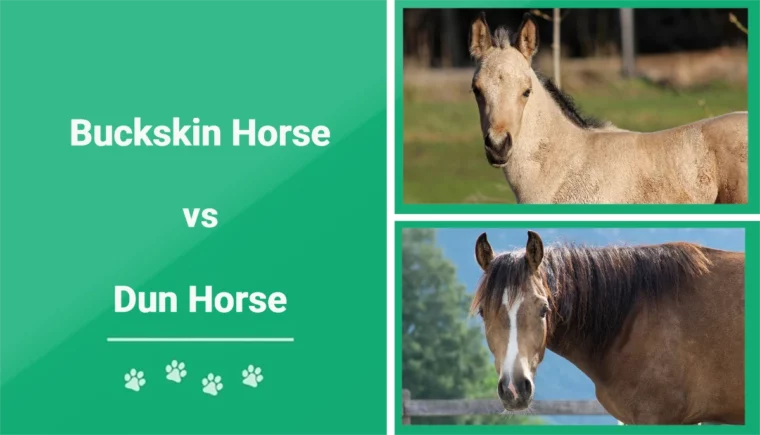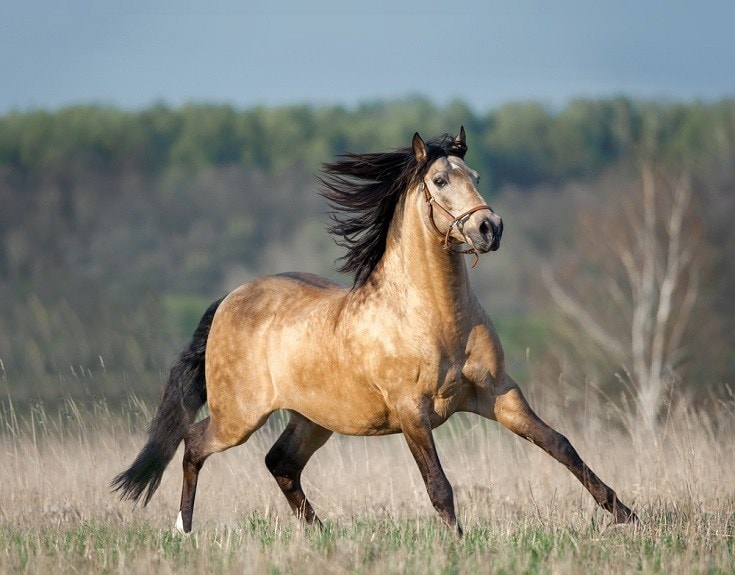
Contrary to what many believe, the buckskin and dun are not two different horse breeds. Rather, the names buckskin and dun refer to the colors of the horses’ coats. The colors are the result of the genetic makeup of the horse.
Both the buckskin and dun coloring result from a dominant gene. Buckskin happens when the cream dilution gene works on a bay-colored horse. Bay horses are reddish-brown with black manes, tails, and legs. As a result, the addition of the cream dilution gene produces a horse that is light tan or gold in color with a black mane, tail, and lower legs.
The dun color is the result of the dun dilution gene lightening the red and black pigments in a horse’s coat. Their main body color can vary from a light tan, red, or gray, depending on the undiluted version of their coat color. The mane, tail, and lower legs are usually black or a dark version of the undiluted color. The dun horse also has a darker mask marking on its face and a dark dorsal stripe down its back.
Visual Differences

At a Glance
Buckskin Horse Overview

While the term buckskin refers to the coloring resulting from the genetic makeup of the horse, rather than a specific breed, these horses are known to have specific characteristics. Horses with buckskin coloring have a tendency to be hardier than other horses. They have strong legs and feet, which makes them perfect working horses.
The buckskin has been around for a very long time. It is believed they were first brought to North America by the Spanish in the 1500s. Some of these horses were released into the wild and then bred with the wild horses throughout the west. Because of their strength and intelligence, the buckskins were often used by cowboys.
The buckskin is also familiar to many of us because they are often used in television and film. For example, the horses heavily featured in Dances with Wolves, Bonanza, Spirit, and Gunsmoke were all buckskins.
Health & Care
Because the buckskin is just a name for the coloring, not a specific breed, their care doesn’t require much in the way of special tasks. However, there are a few tips you can follow to ensure your buckskin is beautiful and healthy.
Because of their lighter coat color, you may want to bathe your buckskin more frequently to keep its coat free of mud and dirt. Some owners also claim that the light coat color attracts more flies and other pests than darker coats. Daily grooming and brushing will help you bond with your horse and make sure their body is free of injuries and pests.

Breeding
The buckskin coloring is the result of the cream dilution gene working on a bay horse. The buckskin coloring is found on many different breeds of horses.
Suitable For
The buckskin does well on ranches and in other environments where they can work. Because they are usually hardy, strong, working horses, it is important to know their limits. Generally, horses should carry no more than 15%-20% of their weight. They need to eat about 1%-3% of their body weight each day and need plenty of water as well.
Dun Horse Overview

Dun horses are quite beautiful. They can be differentiated from the buckskin by the range of coat base colors and the strip running along their back. Dun horses can be tan, like the buckskin, but they can also be reddish-brown or gray. The strip on the back and the darker coloring around the face are usually darker versions of the base coat color. Some dun horses also have darker shoulder stripes.
The dun coloring can be traced back to the Stone Age. They are believed to be one of the oldest color variations in horses. Some horses in cave drawings have distinct dun markings, leading historians to believe the dun horse was common in the wild and under human care at that time.
It is interesting to note that a horse cannot be both buckskin and dun. It can only be one or the other.
Health & Care
Like the buckskin, the dun has few care needs that would not be typical of any horse. They need daily grooming and plenty of fresh water. Their food needs are determined by their size and activity levels.
Breeding
Interestingly, there are only a few breeds of horses that only come in the dun coloring. These include the Fjord Horse of Norway and the Przewalski Horse, a wild horse found in Central Asia.
Suitable For
Duns can be any breed of horse that has the special markings and colorings brought on by the dun dilution gene. Therefore, the best use of a specific dun horse depends on the breed and personality of the horse.
Which One Is Right for You?
Since the buckskin and dun refer merely to the coloring, the right horse for you depends on how you plan to use your pet. The cream dilution gene in buckskins does tend to produce a hardy, strong horse suitable for working. The dun dilution gene can mix with any other horse breed, so there is great variance in the dun horse’s strengths and abilities. The coloring of these two beautiful horses does mean it may take more work to keep them clean, especially if you are considering a buckskin or lighter-colored dun.
Featured Image: Top – Linzmeier1, Pixabay | Bottom – Pezibear, Pixabay









